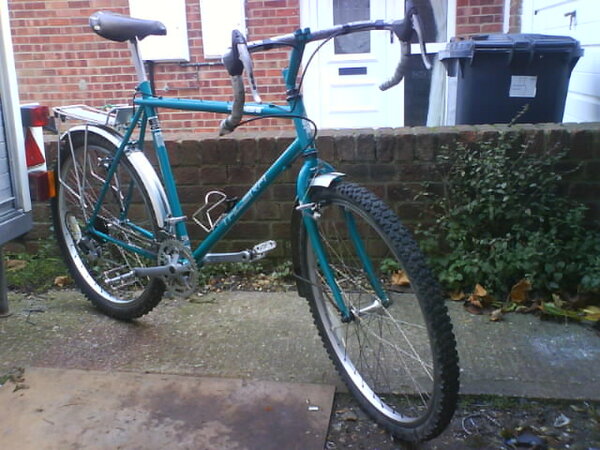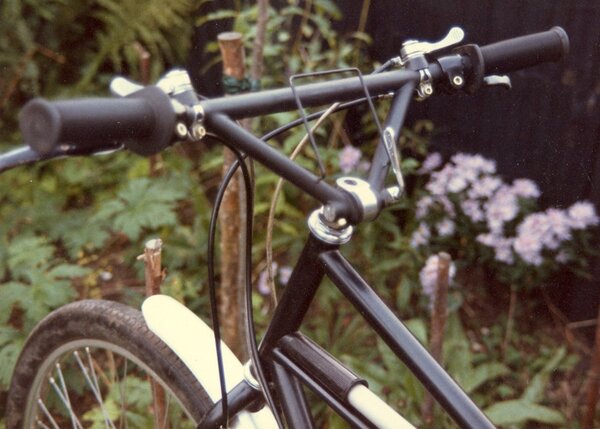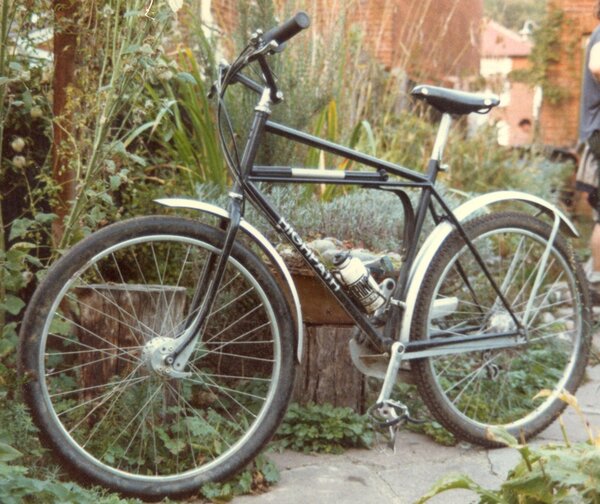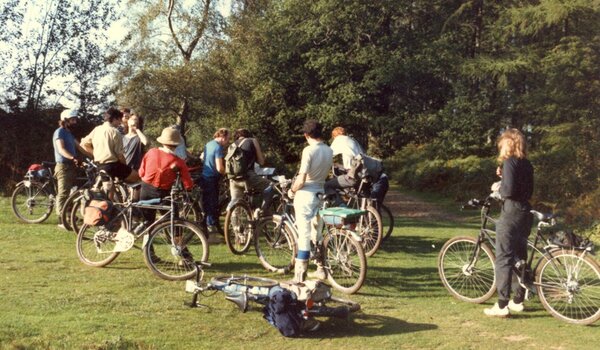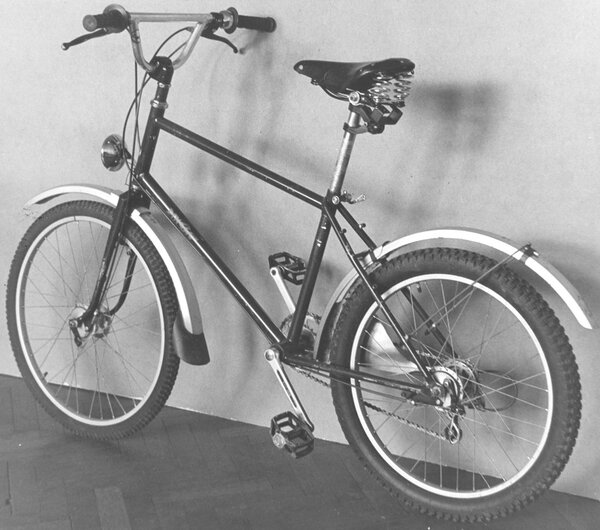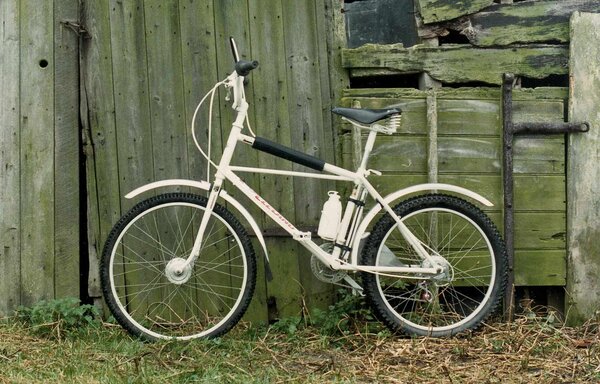1979 and all that
Mornin' all!
I've just scanned back over this thread and thought I'd tie up a few loose ends:
When was the true start of mountain biking? MrK suggests when the repackers began cycling up the hill before riding down.
My feeling is that the beginning has more to do with critical mass;
one person engaged in an activity = an eccentric
two people so engaged = two eccentrics
three ditto = a movement
I felt critical mass in this country was met on the occasion of the Small Dole event, Sussex, 1985.
There were several turning points for me there, here are some:
- One I mentioned earlier in this thread, about being too ahead of my time.
- There was a timed downhill slalom event, with about seven teams of four riders. Timing began when the first rider entered the section, and ended when the last rider passed the exit. The Cleland team could muster only three willing members, due to the generally non-cometitive nature of our contingent. Times between 36 & 42 seconds were being recorded. So, you can tell, it was a short downhill and the time differences were caused by some teams coming down swiftly, and others getting tangled or falling. They were generally sporting types in shorts & tee-shirts, stripped-down classic mountainbike of the time. We were the last to go down, we had just cycled about 25miles to get there, were all kitted out with panniers, muguards, lights etc. We made a time of 28 seconds, but were disqualified because we were only three. There was no wrangling, we knew we'd no chance of winning; did it demonstrate the prowess of the Cleland design? No, of course not! . . . if a Cleland failed at something, the reason was "it's because the design of the bike is all wrong". If we succeeded; "it's because you are skilled and experienced riders". I knew it was the other way round and I wasn't going to win this one for a good many years.
- Jeremy Torr had one of his bikes on the Middlemores trade stand. Middlemores at that time were the sole importers for Shimano. To his bike was fitted the first 'Biopace' chainset. "You've fitted this the wrong way round" I said to Jeremy. "Nope" he replied, and showed me all the technical paperwork. That was when I learned that the top experts can **** up good and proper. It put the kybosh on all the efforts of Chris Bell, and screwed what was a major breakthrough in bicycle technology. However, you can still buy EggRings, but you can't get Biopace for love nor money, and why would you want to?
Yep, Small Dole, August 1985
ededwards: it is good to question your beliefs, it is good to question everything.
I hope everyone who reads this stuff I'm writing about bicycle design questions what I say. Don't just believe me, or write me off as an idiot; take in all the evidence, add it to your experience, add it to your power of imagination, add it to your creative potential, and only then, begin to think for yourself. Then, once you've reached your conclusion, and you're sure you've got it right, say to yourself "could it be done better?"
Now, I hope The Big Cheese doesn't get offended; I've tried to think of a way to say this without seeming rude, or offensive, but, well, here goes...
You say your machine is inspired by this thread, but I don't get it. The handlebar/saddle distance should be short ~ never mind the height; a high front end does not necessarily mean a rearward weight bias. Then you slip in the phrase "lazy angles". The angles in a frame are meaningless ~ they had relevence in the days when frame builders used the top tube as the datum. It could be generally said that steeper angles from the horizontal top tube would make a 'faster' machine, and less steep angles, a 'slower' bicycle. But this is such an over-simplification as to be so much bollocks. I can expand on this at length, but only if asked. In straightforward terms: frame angles alone mean nothing, unless you can relate them to other factors/dimensions.
Sorry if that sounds a bit abrupt, it is.
Life's way too short.
There goes my alarm ~ time to stop this and start the day. I must do a bit on centre of gravity and steering geometry next time, plus an Aventura of 1982 and a Dingbat.
Seey'll
Mornin' all!
I've just scanned back over this thread and thought I'd tie up a few loose ends:
When was the true start of mountain biking? MrK suggests when the repackers began cycling up the hill before riding down.
My feeling is that the beginning has more to do with critical mass;
one person engaged in an activity = an eccentric
two people so engaged = two eccentrics
three ditto = a movement
I felt critical mass in this country was met on the occasion of the Small Dole event, Sussex, 1985.
There were several turning points for me there, here are some:
- One I mentioned earlier in this thread, about being too ahead of my time.
- There was a timed downhill slalom event, with about seven teams of four riders. Timing began when the first rider entered the section, and ended when the last rider passed the exit. The Cleland team could muster only three willing members, due to the generally non-cometitive nature of our contingent. Times between 36 & 42 seconds were being recorded. So, you can tell, it was a short downhill and the time differences were caused by some teams coming down swiftly, and others getting tangled or falling. They were generally sporting types in shorts & tee-shirts, stripped-down classic mountainbike of the time. We were the last to go down, we had just cycled about 25miles to get there, were all kitted out with panniers, muguards, lights etc. We made a time of 28 seconds, but were disqualified because we were only three. There was no wrangling, we knew we'd no chance of winning; did it demonstrate the prowess of the Cleland design? No, of course not! . . . if a Cleland failed at something, the reason was "it's because the design of the bike is all wrong". If we succeeded; "it's because you are skilled and experienced riders". I knew it was the other way round and I wasn't going to win this one for a good many years.
- Jeremy Torr had one of his bikes on the Middlemores trade stand. Middlemores at that time were the sole importers for Shimano. To his bike was fitted the first 'Biopace' chainset. "You've fitted this the wrong way round" I said to Jeremy. "Nope" he replied, and showed me all the technical paperwork. That was when I learned that the top experts can **** up good and proper. It put the kybosh on all the efforts of Chris Bell, and screwed what was a major breakthrough in bicycle technology. However, you can still buy EggRings, but you can't get Biopace for love nor money, and why would you want to?
Yep, Small Dole, August 1985
ededwards: it is good to question your beliefs, it is good to question everything.
I hope everyone who reads this stuff I'm writing about bicycle design questions what I say. Don't just believe me, or write me off as an idiot; take in all the evidence, add it to your experience, add it to your power of imagination, add it to your creative potential, and only then, begin to think for yourself. Then, once you've reached your conclusion, and you're sure you've got it right, say to yourself "could it be done better?"
Now, I hope The Big Cheese doesn't get offended; I've tried to think of a way to say this without seeming rude, or offensive, but, well, here goes...
You say your machine is inspired by this thread, but I don't get it. The handlebar/saddle distance should be short ~ never mind the height; a high front end does not necessarily mean a rearward weight bias. Then you slip in the phrase "lazy angles". The angles in a frame are meaningless ~ they had relevence in the days when frame builders used the top tube as the datum. It could be generally said that steeper angles from the horizontal top tube would make a 'faster' machine, and less steep angles, a 'slower' bicycle. But this is such an over-simplification as to be so much bollocks. I can expand on this at length, but only if asked. In straightforward terms: frame angles alone mean nothing, unless you can relate them to other factors/dimensions.
Sorry if that sounds a bit abrupt, it is.
Life's way too short.
There goes my alarm ~ time to stop this and start the day. I must do a bit on centre of gravity and steering geometry next time, plus an Aventura of 1982 and a Dingbat.
Seey'll
